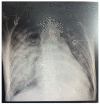Delayed Surgical Management of Acute Type A Aortic Dissection in a Patient with Recent COVID-19 Infection and Post-COVID-19 Bronchopneumonia-Case Report and Review of Literature
- PMID: 36295518
- PMCID: PMC9609154
- DOI: 10.3390/medicina58101357
Delayed Surgical Management of Acute Type A Aortic Dissection in a Patient with Recent COVID-19 Infection and Post-COVID-19 Bronchopneumonia-Case Report and Review of Literature
Abstract
Ever since it was first described in 1760, acute type A aortic dissection has created difficulties in its management. The recent COVID-19 pandemic revealed that extrapulmonary manifestations of this condition may occur, and recent reports suggested that aortic dissection may be amongst them since it shares a common physiopathology, that is, hyper-inflammatory syndrome. Cardiac surgery with cardiopulmonary bypass in the setting of COVID-19-positive patients carries a high risk of postoperative respiratory failure. While the vast majority accept that management of type A aortic dissection requires urgent surgery and central aortic therapy, there are some reports that advocate for delaying surgery. In this situation, the risk of aortic rupture must be balanced with the possible benefits of delaying urgent surgery. We present a case of acute type A dissection with COVID-19-associated bronchopneumonia successfully managed after delaying surgery for 6 days.
Keywords: COVID-19; bronchopneumonia; cardiopulmonary bypass; malperfusion syndrome; respiratory failure; type A aortic dissection.
Conflict of interest statement
The authors declare no conflict of interest.
Figures







Similar articles
-
Endovascular Fenestration/Stenting First Followed by Delayed Open Aortic Repair for Acute Type A Aortic Dissection With Malperfusion Syndrome.Circulation. 2018 Nov 6;138(19):2091-2103. doi: 10.1161/CIRCULATIONAHA.118.036328. Circulation. 2018. PMID: 30474418 Free PMC article.
-
Hybrid stepwise external wrapping for type a acute aortic dissection with cerebral Malperfusion.J Cardiothorac Surg. 2021 Jan 11;16(1):11. doi: 10.1186/s13019-020-01381-y. J Cardiothorac Surg. 2021. PMID: 33430862 Free PMC article.
-
Type A Aortic Dissection During COVID-19 Pandemic: Report From Tertiary Aortic Centers in the United States and China.Semin Thorac Cardiovasc Surg. 2021 Summer;33(2):303-312. doi: 10.1053/j.semtcvs.2020.10.034. Epub 2020 Nov 7. Semin Thorac Cardiovasc Surg. 2021. PMID: 33171243 Free PMC article.
-
Management of acute type A aortic dissection during COVID-19 outbreak: Experience from Anzhen.J Card Surg. 2021 May;36(5):1659-1664. doi: 10.1111/jocs.15041. Epub 2020 Sep 16. J Card Surg. 2021. PMID: 32939857 Review.
-
Ruptured aortic dissecting aneurysm in Turner's syndrome: a case report and review of literature.Ann Thorac Cardiovasc Surg. 2000 Aug;6(4):275-80. Ann Thorac Cardiovasc Surg. 2000. PMID: 11042487 Review.
Cited by
-
The Role of POCUS and Monitoring Systems during Emergency Pericardial Effusion in the NICU.Life (Basel). 2024 Sep 2;14(9):1104. doi: 10.3390/life14091104. Life (Basel). 2024. PMID: 39337888 Free PMC article.
-
Spontaneous Pulmonary Hematoma: Case Report of a Giant Post-COVID-19 Hematoma and Literature Review.Healthcare (Basel). 2023 Feb 10;11(4):527. doi: 10.3390/healthcare11040527. Healthcare (Basel). 2023. PMID: 36833061 Free PMC article. Review.
-
COVID-19 Infection and Massive Aortic Dissection.Clin Case Rep. 2024 Dec 3;12(12):e9659. doi: 10.1002/ccr3.9659. eCollection 2024 Dec. Clin Case Rep. 2024. PMID: 39629037 Free PMC article.
-
Association between Bilateral Selective Antegrade Cerebral Perfusion and Postoperative Ischemic Stroke in Patients with Emergency Surgery for Acute Type A Aortic Dissection-Single Centre Experience.Medicina (Kaunas). 2023 Jul 26;59(8):1365. doi: 10.3390/medicina59081365. Medicina (Kaunas). 2023. PMID: 37629655 Free PMC article.
-
Acute type A aortic dissection patients undergoing surgical repair during the COVID-19 pandemic.Medicine (Baltimore). 2025 Apr 25;104(17):e42249. doi: 10.1097/MD.0000000000042249. Medicine (Baltimore). 2025. PMID: 40295228 Free PMC article.
References
Publication types
MeSH terms
LinkOut - more resources
Full Text Sources
Medical

